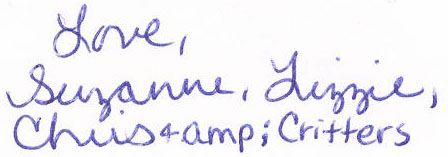Trying out the Scriptless Flickr Badge, which pulls out random selections from 300 of the most recent posts to my Flickr photostream:
Reload to see new selections.
Trying out the Scriptless Flickr Badge, which pulls out random selections from 300 of the most recent posts to my Flickr photostream:
Reload to see new selections.
Posted in crackbaby, meaningless, tech, toys
I had to sign a form tonight that has this legalese about permissions I’m granting to ACM by submitting my abstract to an evolutionary computing conference. Maybe I’m not around legal-speak enough to think that using the term ‘universe’ this seriously is not at all strange:
Here is the latest toy that I made for my AI course:
Shiny Four is a Connect Four implementation, using a minimax search with alpha-beta pruning, written in JavaScript. The JavaScript makes it quite slow and inefficient. But it works. Kinda. If you play against the computer, it will take a few moments (5 to 10 seconds on my machine) for it to make its move. Try to beat the coldhearted machine!
The Artificial Intelligence course I’m taking now is turning out to be very interesting and fun. I gathered much geeky satisfaction from resurrecting (read: “stealing”) old Ultima IV graphics for a pathfinding project that I wrote as a web application:
Click here to play with it. It’s very JavaScript-heavy, so it needs a modern browser that doesn’t suck. It works in IE but prefers Firefox and Safari.
Google Reader is awesome and all, but man, their error messages are quite useless sometimes:

Posted in computing, funny, meaningless, tech
Through the Illinois Genetic Algorithms Laboratory blog, I learned of the Lemelson-Illinois Student Prize, a $30,000 award given to outstanding student inventors. The selection process for the prize is down to eight finalists, one of whom has created an amazing method to translate thoughts into speech:
Michael Callahan Graduate Student – Industrial and Enterprise Systems Engineering, College of Engineering
Michael hopes to assist individuals without the use of speech and mobility communicate through the application of neuroscience. By interfacing near the source of vocal production, he has been able to translate unspoken thought of the mind from intercepted neuronal activity at the vocal cords. The method that Michael has developed produces complete fluent speech with 70% accuracy from neurological signals.
Incredible. I can’t wait to see this kind of technology in use. It might complicate poker games, though.
Today we received a holiday ham sent to us through Heavenly Ham by family members in Texas. The delivery guy handed me a small card with our family members’ greeting hand-written on it by somebody at HeavenlyHam.com. When I saw the following, I immediately recognized that the card was transcribed from a web-based form:

Yes, it says “Chris & Critters”.
An explanation for those of you that don’t speak HTML:
In HTML, if you want to write “Bob & Nancy”, you can’t just write the “&” directly, because it has a special meaning to HTML: it begins a character entity reference. In your HTML source, you have to write it as: “Bob & Nancy”. The browser will show this as “Bob & Nancy“. Well, someone at HeavenlyHam.com had the tedious task of hand-writing all the Web-form-submitted holiday greetings to include in the shipments of delicious goodies. This unlucky person didn’t translate the “&” back to “&“. Which amused me immensely, because I: 1) am a web developer, and 2) am easily amused.
Sweet Lord, my Genetic Algorithms course has ended. The giant pile of work is now behind me. I have to say that despite the large amount of work, the course has been one of the most rewarding in recent memory. There are a lot of exciting ideas in this field. The course instructor is David E. Goldberg, who is an influential luminary in the field.
For the course project, I decided to return to my decades-old interest in graphics programming by developing a genetic artwork program. The basic idea was to “breed” new images by figuring out which images in a random population are better than others. I needed a way to rank which images were better than others. Inspired by Flickr’s concept of interestingness, I decided to use color comparisons to popular images from Flickr.com as a way to rank images. An image that has a close match in color to a popular or interesting Flickr image is given a high rank. The genetic algorithm runs over successive generations to produce images with higher ranking. Eventually I got a lot of good results, and then a scary demon appeared:

The picture on the left is the Flickr image that the generated images resembled most. Lower numbers mean higher rankings. Look at 392. The demon got 4th place! Maybe that’s why he looks angry.
Here are some other interesting results I got with the demon’s paintbrush. Click to get to a more detailed writeup, including the many thousands of generated results:
UPDATE: Click here to see some giant tiled montages of artwork generated by the technique.
I like the fact that Amazon.com, in their product recommendations, offered me books on these two subjects right next to each other:

Yes, computers and anger are a natural fit. Amazon.com knows this. The technology wins every time, and we are left to fume at its dominance over us, as this classic clip perfectly captures:
Posted in computing, funny, meaningless, pain, tech